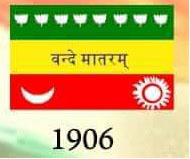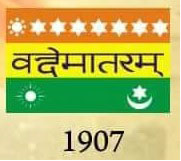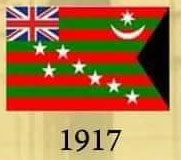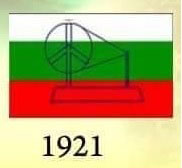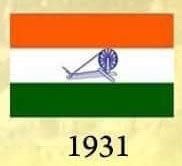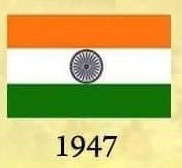NATIONAL FLAG
Q2. When and who proposed a flag for India and what it looked like?
SISTER NIVEDITA - a disciple of Swami Vivekananda, was the first to propose a flag - a red square one with a thunderbolt and white lotus at the center and "Bande Mataram" inscribed in Bengali in 1904.
Q3. When was the first tricolour flag brought out and how was it called then?
7.8.1906 - First tricolour flag was unfurled at Kolkatta during a protest rally by Sachindra Prasad Bose. It was called a "Calcutta flag".
Q4. When and who was the first to unfurl an Indian tricolour flag abroad, where was it done and how was it called then?
22.8.1907 - Bhikaji Rustom Cama along with Veer Savarkar and Shyamji Krishna Rao, designed a tricolour flag in Green Saffron and Red bands, with eight green lotus, and, Vande Mataram in Devnagari script. It was unfurled at the Berlin Committee, Germany and hence it was called the "Berlin Flag".
Q5. When and who designed a tricolour flag similar to the present one?
1931 - PINGALI VENKAYYA - from Andhra Pradesh, who was a railway guard - proposed a tricolour flag with saffron, white and green bands, with "Charka" (spinning wheel) on the white band in Blue Ochre colour. It was approved by the Congress Working Committee, on 2.4.1931 and unfurled for the first time in this session at Karachi. It became the flag of Indian National Congress.
Q6. What was the change made to the flag of the Indian National Congress that became our National Flag later?
At the dawn of independence, a committee consisting of Dr.Rajendra Prasad Abul Kalal Azad, Sarojini Naidu, K M Munshi, B.R. Ambedkar and Rajagopalachari, was constituted to propose a National Flag. The committee recommended the same INC flag with only one change. The "Charka" was replaced by "Dharma Chakra " (wheel with spokes) in the same Blue Ochre colour in the white band. It was approved for adoption on 14.7.1947, with Saffron, white and Green horizontal bands, with Dharma Chakra on the white band.
Q7. When was the National Flag first unfurled?
15.8.1947
Q8. What is the ISI (now BIS) code for the National Flag?
ISI - 1.
Q9. In which material (textile) alone, the National Flag can be manufactured?
Khadi Cotton Cloth.
Q10. What should be the ratio of breadth to length of the National Flag?
2:3
Q11. Which is the only authorized manufacturing unit for the National Flag?
Khadi Gramodhyog Bhavans at Hengeri near Hubli, Karnataka, Assam and only at similar other centres.
Q12. Where from the "Dharma Chakra" was taken and adopted?
Saranath Lion Capitol.
Q13. What should be the size of the wheel with reference to the width of the white band?
3/4 - three fourth.
Q14. How many spokes are there in the wheel of the National Flag?
Twenty four.
Q15. What is the authorized colour of the Chakra?
Blue Ochre (Oxford Blue).
Q16. What does the three band colour represent?
Top - Saffron - Courage and Sacrifice
Middle - White -- Peace and Truth
Bottom - Green -- Faith and Chivalry.
Q17. What are the standard sizes of National Flag and where they are hoisted?
|
SIZE(LENGTH/BREADTH)....... |
HOISTING PLACE |
|
21' X 14'/6300 X 4200 mm..... |
Very high flagmasts. |
|
12' X 8' / 3600 X 2400 mm..... |
Rashtrapati Bhavan, Raj Bhavan and Parliament House. |
|
8' X 6' / 2700 X 1800 mm....... |
Parliament House and other medium sized public buildings. |
|
6' X 4' /1800 X 1200 mm........ |
Small sized public buildings and during state and military functions. |
|
4.5' X 3' /1350 X 900 mm....... |
Smaller sized buildings. |
|
3' X 2' /900 X 600 mm............. |
On rooms, cross bards and walls. |
|
18" X 12" / 450 X 300 mm...... |
VVIP's aircraft and President's Train. |
|
9" X 6" / 225 X 150 mm........... |
VVIP's motor cars. |
|
6" X 4" / 150 X 100 mm |
As table flags. |
Q18. What is the period of the day during which the National flag can be flown?
Sunrise to Sunset.
Q19. What procedure should be followed while hoisting and lowering of the National Flag?
Hoisting should be brisk and lowering should be slow. If bugle calls are accompanied, then it should synchronize with it.
Q20. What are the important occasions of flying of National Flag?
26th January Republic Day;
15th August Independence Day;
2nd October Gandhiji's birth day.
6th to 13th April - National week in memory of Jalianwala Bagh incident.
Any other day of rejoice as decided by the Government.
Q21. Our National Flag, when displayed in straight line along with other country flags, what should be its order?
It should be extreme right. If a dignitary was to stand in the centre of the row of flags, facing the audience, then the National Flag should be to his right.
Q22. What are the instructions on "half mast" flying?
National Flag shall be flown at half mast, only on occasions of grief of national importance. Following are the occasions of national mourning and the number of days of observance is decided by the government.
1. Demise of President, Vice President and Prime Minister - in service. -- throughout India.
2. Speaker, Chief Justice, and Ministers. -- Delhi Municipal Area and Union State Capitals
3. Governor, Chief Minister and State Ministers Throughout the State and UT concerned.
4. Any other occasion of National Mourning as decided by the Government.
Q23. What is the general instructions on disposal of the National Flag?
There are very many of them. However, in general, when the flag is no more in a fit condition for use, it should be disposed of in a dignified manner preferably by burning or ground burial, without the usual shows or gathering attached with such occasions.
Q24. Which businessman and a Member of Parliament won a case in Supreme Court for hoisting of National Flags on non-governmental buildings?
Naveen Jindal of Indian National Congress. This was subsequently regularized by the Government with effect from 26.1.2002.
Q25. When was the National Flag of India, hoisted for the first time on Mount Everest?
29.5.1953 by Tenzing Norgay.
Q26. When and by whom the tri-colour was first hoisted in the A & N Islands?
Nethaji Subhas Chandra Bose in 1943.
